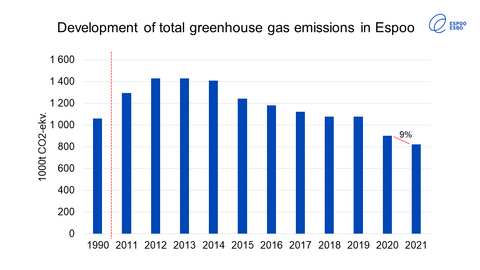Climate emissions in Espoo dropped again – “Our goal is to become a carbon-neutral city by 2030.”

HSY's emission calculation indicates that Espoo's total emissions dropped by nine per cent in 2021, even though district heating production and electricity consumption increased significantly in the Helsinki metropolitan area.
The heating season in 2021 was cold compared to 2020. Despite this, climate emissions continued to decrease towards the carbon-neutral Espoo by 2030 goal. Espoo's total emissions decreased by 9% and emissions per capita by 10% compared to 2020. Espoo's emissions per capita, 2.8 tonnes CO2e, were the lowest in the Helsinki metropolitan area for the fifth consecutive year.
The largest source of emissions is the heating of buildings, where the largest reductions in emissions were also achieved. Espoo and Fortum will continue their journey towards abandoning coal in district heating by 2025. In 2021, the use of coal decreased by about one quarter from the previous year. Already more than half of district heating in Espoo is produced using renewable energy sources. In district heating, emissions decreased by more than 15% compared to the previous year.
In the spring, Microsoft and Fortum announced a collaborative project for a new data centre where Fortum will utilise waste heat from the centre in district heating. Utilising waste heat in district heating will further reduce the climate emissions of the city.
“The use of pure waste heat in district heating will help us immensely in our goal towards a carbon-neutral Espoo by 2030. The most important individual climate action is stopping the use of coal by 2025. Together with our partners, we are constantly developing new innovative and clean urban solutions in order to achieve our common goal,” says Mayor Jukka Mäkelä.
Low-emission transport and smart solutions
After heating, traffic and electricity consumption are the main regional sources of greenhouse gas emissions. In 2021, Espoo generated around one tonne of traffic emissions per capita and half a tonne of emissions from electricity consumption per capita. Compared to the previous year, emissions decreased by around 2%.
In order to achieve the carbon neutrality target, the total emissions from transport must also start to decrease in Espoo. Achieving the objective requires both an increase in the share of sustainable modes of transport and a shift from fossil fuels to non-fossil fuels. The Espoo public transport trunk network will develop significantly during the current City Council term of office, when service starts on the Jokeri Light Rail extension of the Länsimetro. The charging infrastructure for electric cars and other electric vehicles will be developed in collaboration with partners.
In the spring, the European Commission selected Espoo to carry out the 100 Climate-Neutral and Smart Cities Mission. “This will further strengthen Espoo's role as a key European development environment for solutions that promote the region's competitiveness and for which there is demand elsewhere,” says Strategy Director (temp.) Pasi Laitala.
During 2022, the carbon-neutral Espoo 2030 roadmap, compiling the climate work of the City and the Espoo community into a strategic plan, will be submitted to the City Council for decision. In addition to reducing emissions in urban areas, the aim is to ensure that urban growth remains sustainable and solutions developed with partners also contribute to solving the global climate challenge.
Greenhouse gas emissions in the Helsinki metropolitan area are calculated based on consumption. Indirect emissions from consumer goods, such as food or construction products, are not taken into account in the calculation.
In 2013, Espoo launched a cross-administrative sustainable development programme which has reduced the City's greenhouse gas emissions together with companies in the region for two consecutive terms of office. Boosted by the ongoing third term, Espoo will become a carbon-neutral pioneer city by 2030.